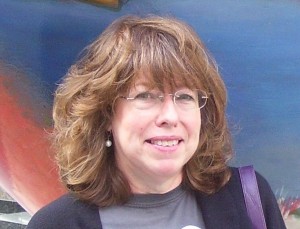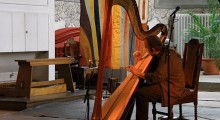Based in Atlanta, GA, Lucy Banks is an intern with the Music for Healing and Transitions Program, which, according to their website, is a “national educational certification program preparing musicians to provide live, therapeutic music at the bedside.” She spoke with us about her personal experiences training with MHTP, and about the uses and practices of therapeutic music.
Antal: What is therapeutic music? What does Music for Healing and Transitions Program do?
Lucy: MHTP is an organization certified by the National Standard’s board for therapeutic musicians. We prepare musicians to perform live, therapeutic music. It’s a very specific skill. You become a CMP, a Certified Music Practitioner. You learn how to play at bedsides, and to assist in life transitions.
Antal: How long have you been playing therapeutic music, or just plain music?
Lucy: I have a pretty strong background in music, I’ve been playing since I was very young and I’ve been studying various modes of healing music for a few years now. As for MHTP, for therapeutic music, there are 5 full weekends of training modules with different instructors who teach you about musicianship, concepts of healing and its relation to music. Then there’s a 3-Day clinical practicure here at Emory Healthcare Clinical, when we participate in active hospice programs, playing for patients under supervision.
Antal: Do most hospitals offer this program?
Lucy: Most CMP’s do hospice work, and yes, a lot of hospitals have therapeutic musicians on call. Sometimes it’s volunteer work, sometimes it’s professional. There is a lot of demand for these services once people become aware that they are offered.
Antal: What has your experience with MHTP been like? Where are you in the training process?
Lucy: Like I said, I’ve just now finished my five weekends of training modules, and soon I will be starting my internship, taking volunteer opportunities, and then I will be working with hospice patients. MHTP requires 45 hours of playing time to complete the internship. So far, I’ve spent a lot of time talking and being with the dying, learning to be comfortable. MHTP accepts all melodic instruments. The chalice of repose, there are a lot of harp players that do this work, viola de gamba, flute, guitar. There are keyboardists and pianists as well.
Antal: What are they teaching you?
Mostly structure, repertoire, technique, what types of music are appropriate for what types of conditions. That’s very important. This is all about mood. Even classical — when you are playing for the very ill, you need to learn simple things, how to play for them in particular. Playing something familiar, something they heard often in their own lives, can keep them in the here and now rather than lead to their passing.
Antal: So what kind of music are you playing?
Lucy: Well, its not typical sort of music. It’s more like an interaction. We are learning to focus and observe what’s happening with the patient, what sort of reaction they’re having to the sounds that they are hearing. It’s a physical thing. It’s tied in with body chemistry and your own specific physical make-up, as well as the associations you might have with the certain kinds of musics.
Antal: How do you know what music is best to play?
Lucy: Well, sometimes we ask the families but mostly we use our training and our judgment. Dementia patients, for instance, have favorable reactions to familiar music. You have to learn about the different patient conditions, what’s right for which situations. It’s not necessarily playing what the family wants to hear. You know, sometimes families will have a few songs in mind that they want to hear, but the music we play is really about the patient not about what other people want to hear. We are oriented absolutely towards the dying person, and we can have a great effect on them. Everyone benefits from music, even the doctors. We change the mood in a place, and in a situation as emotionally as hospice situations can be, this can be a very valuable service in and of itself.
Antal: Well, thanks so much for your time, and best of luck with your new profession!
Lucy: Thanks, it was a pleasure.
- Learn more about the therapeutic value of specialized sounds in our interview with Candace Keach, a participant in the Sprial Sounds of Crystal Bowls
- Read our review of the Pulitzer Prize winning play, “Wit,” by Margaret Edson, about a dying woman’s journey towards self-discovery

 What is Therapeutic Music? – An Interview with Lucy Banks
What is Therapeutic Music? – An Interview with Lucy Banks




 Forest Bathing Eases Grief by Soaking in Nature
Forest Bathing Eases Grief by Soaking in Nature
 The Spiritual Symbolism of Cardinals
The Spiritual Symbolism of Cardinals
















a touching interview
Report this comment
Thanks, and thanks for reading.
Report this comment